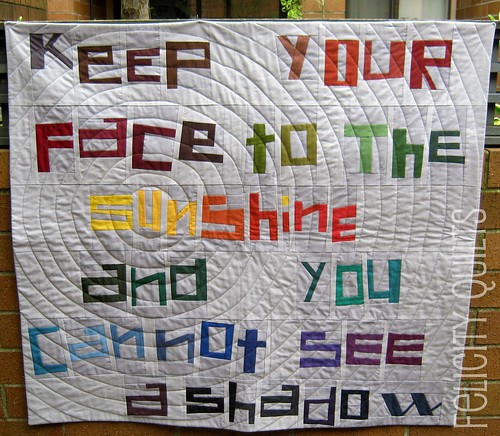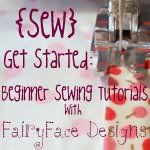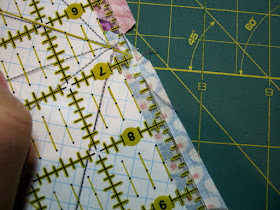
Thursday tutorial time again! This week I am really happy to have my Canadian friend Felicity join me to show you a new technique. Felicity was my swap partner last year in the "For the Love of Solids" swap and I got to know her quite well through all that stalking! I love her super modern style - I had not really come across improv piecing or Gees Bend quilts or any of that really cool stuff until I started researching what she liked, and I'm so glad I did. She also introduced me to free pieced letters - I think this is my very favourite quilt of hers, and was total inspiration to me!
So, Felicity, it's over to you!
I'm completely thrilled to be participating in this fantastic series of tutorials. Thanks for inviting me, Sarah.
In this project you'll learn one way of foundation paper piecing, how to make bias binding, and how to attach bias binding to a round project. Excited? Me too! I suggest you have a read through the instructions before getting started. Let's go!
Materials/Tools you'll need for two scrappy potholders:
1 large mixing bowl, plate or other round thing, about 8” diameter
2 pieces lightweight paper (newsprint or cheap printer paper)
1 small drinking glass, about 2” or 2½” diameter
Lightweight fusible interfacing
Pile o’ scraps of varying sizes, at least 4”x5” for piecing potholder fronts (number depends on number of wedges in your wheel)
2 @ 4” squares of solid or contrasting fabric for center circles
2 @ 10” squares of backing fabric
2 @ 10” squares 100% cotton batting
2 @ 10” squares insulated batting (example: InsulBrite)
2 @ 10” squares 100% canvas (or twill)
Fat Quarter for bias binding (see Step 5 for instructions)
8” x 2” strip of fabric for hanging tabs (optional)
Rotary cutter, ruler, mat (with 45 degree line marked)
Add a quarter ruler (optional)
Pencil and ruler
Note: reduce the length of your stitch and use a larger needle (say 90/14) to make removing the foundation paper easier. The following steps are for making one potholder.
Step 1 – Creating the Paper Foundation.
1. Place mixing bowl on paper and trace it to create a circle. Cut out the circle leaving about ¼" around the outside.
2. Fold the circle in half making sure to match up the edges, and then cut the circle in half on this fold (the diameter) to create two semi-circle foundations.
3. Using a ruler, draw randomly spaced wedges all the way around each semi-circle – the size is up to you. The wedges don’t have to meet exactly in the centre, but they should be relatively close. The more wedges, the scrappier the potholder will be.
Step 2 – Piecing the Potholder.
1. Take a semi-circle, and write a 1 inside the first wedge, then move to the wedge directly beside that one and write a 2 inside it and so on until all the wedges are numbered. Make a fold in the foundation on all stitching lines, then open up foundation.
2. Choose your first scrap and place it WRONG side together with the WRONG (unmarked) side of the foundation. Hold the foundation up to the light and make sure the scrap completely covers wedge 1 and extends at least ¼” beyond it on all sides. Secure with a little bit of glue stick if you want.
5. Fold back the template along the line you just stitched and trim the fabric seam allowances to ¼” using your Add a Quarter ruler or other rotary cutter ruler.
6. Flip scrap over and press.
7. Repeat steps 3 through 6 all the way around the semi-circle until all the wedges are pieced. The center bits are going to look messy – that’s okay, we’ll be covering up that mayhem with an appliqué!
8. Make 1 more semi-circle this way - the other half of your potholder top.
9. Trim each semi-circle ¼” away from the diameter.
10. Put 2 semi-circles together ensuring you’ve lined up the diameters,
11. If the seams at the circle’s centre are too bulky, trim a very small hole by cutting a semi-circle into the centre of the stitched-together semi-circles. The hole you cut out has to be covered by your centre appliqué, so don't cut it too big!
12. Trim around the foundation circle on the outside line, and tear away the foundation paper.
13. Open up the circle and press the joining seams to one side.
Step 2a - Optional Pieced Wedge
1. If you really want to up the Scrap Factor, you can piece a wedge using strips. Choose 3 strips that are both wide and long enough to cover the wedge once they're pieced.
2. Piece them together then just treat them like any other scrap.
Step 3 – adding the centre circle using Poppyprint’s method.
1. Take your 4” square of solid or contrasting fabric and trace a circle on the wrong side using a drinking glass or other circular thing.
2. Cut a 4” square of your fusible interfacing and place the fabric’s right side together with the interfacing’s fusible side. Pin if desired.
3. Stitch all the way around the circle on the line you traced and backstitch at the beginning and end of your seam.
4. Trim around the circle creating a 3/8” seam allowance.
5. Pinch the interfacing to separate it from the fabric, then cut a slit in the interfacing taking care not to cut the fabric.
6. Carefully turn the circle inside out and GENTLY poke out the curves using something blunt.
7. The puffy circle will likely have some interfacing showing at the sides. Pinch/squeeze the edges with your fingers to smooth these out as much as possible. Don’t use an iron because it will melt the fusible goo on the interfacing.
8. Place the circle on the centre of the pieced-together wedge and using a hot iron, press in place to activate the fusible interfacing. NOTE: If you’ve cut out the centre to manage the bulky point where all the seams meet, then be sure you put a small scrap under the circle so that you don’t fuse the circle onto your ironing board where the interfacing shows through the centre hole. If you want to remove the scrap (it will be covered by the circle), then pull the scrap off while the goo is still warm, or you could just leave it.
9. Reinforce the appliquéd circle by stitching around it with a zigzag or blanket stitch now, or you can incorporate that into your quilting as I did.
Step 4 – Layering and Quilting.
1. Make a little quilt sandwich as follows:
- Backing square right side down;
- Insulated batting, shiny/reflective side down;
- Cotton canvas;
- Cotton batting;
- Pieced circle.
2. Baste the layers together. I decided to use pins.
3. With all of these layers, you’re going to need your walking foot. I started my quilting by zigzagging around the centre appliqué.
4. Then I switched to a straight stitch and quilted in a spiral as follows: I went once around the outside edge of the appliqué. When I got to the point where I started, I moved a little to the right as I continued stitching, gradually increasing the distance between the edge of my foot and the previous stitching line until the previous stitching line was right against the left side of my walking foot. Then I just kept on stitching, using the edge of my walking foot as a guide, until I got to the edge of the circle.
5. To make it easier to apply the binding and to stabilize the bias edges of the circle, zigzag around the outer edge of the circle.
6. Trim the extra batting and backing around the circle.
Step 5 – Make Bias Binding. Because a fabric's bias (diagonal) grain is nice and stretchy, bias binding will stretch around the potholder's curves without puckering.
1. Take your FQ and square it up. It will probably be about 17 to 18" square.
3. If your square's diagonal is longer than your long ruler, use two rulers to make sure your long ruler is following the diagonal. Place your long ruler so it goes through the bottom corner along the 45 degree line, and line up a second ruler through the opposite (diagonal) corner along the 45 degree line there. Slide the rulers together and adjust so both are along the 45 degree line and through the corner. Holding your long ruler in place, move the second ruler out of the way and cut along the diagonal until you reach the end of the long ruler. Reposition your long ruler so it lines up with the top corner along the 45 degree line and the line you just cut, and finish cutting.
4. Fold one triangle onto the other.
5. Cut a total of four 2¼" bias strips by making two cuts along the diagonal.
6. Set aside one of the longer strips.
7. Stitch a shorter bias strip to each end of the longer strip.
8. Place angled ends so that they overlap ¼", then stitch, and press seams open.
9. Press this long strip in half, wrong sides together and cut in half.
10. Trim ends square.
Step 6 - Make and Attach Hanging Loop (optional)
1. Cut a 8"x2" strip from your Binding FQ.
2. Press in half lengthwise, right sides together.
3. Open, then press each side in to the centre.
4. Press in half.
5. Topstitch, and cut into two 4" lengths.
6. Fold over and attach to back of potholder with about a 1/8" seam allowance.
Step 7 - Attach Bias Binding
1. Place the binding strip on the right/top side of the potholder, leaving about a 5" tail and start stitching. You will see that I didn't bother with any pins. Just stretch the binding slightly as you go.
3. Slowly stitch all around the potholder and stop when you're about 7" or so from where you started.
4. Find where the binding will meet up and fold back both tails at that point and press.
5. Trim ¼" away from each fold.
6. Unfold the binding and place the ends right sides together. You'll have to squeeze the potholder together to get them comfortably lined up.
7. Stitch with slightly more than a ¼"seam allowance.
8. Press the seam open, then press the binding fold.
9. Finish stitching on the binding using the same technique as step 2, backstitching at the beginning and end.
10. Flip the binding back over the raw edge and press it out toward the edge of the potholder to smooth it out.
11. Stitch the binding down by hand on the back of the potholder.
12. Enjoy!
Thanks so much Felicity, I love it! If you make one of Felicity's potholders, please add to the Flickr group. And don't forget to pop back next week for Jenna's zipped wristlet/pouch.















































Looks great. I hope to try one this weekend!
ReplyDeleteAnother lovely tutorial. Thanks to you and Felicity!
ReplyDeleteOoh smashing!
ReplyDeleteVery very cute tute!!!! Love these.
ReplyDeleteThis is a lovely tutorial, thank you.
ReplyDeleteGenius, I'd never thought of paper piecing a cirlce - doh!
ReplyDeleteFelicity is AWESOME! Great tute for a great idea!
ReplyDeleteVery cute! I will certainly make this with my scraps.
ReplyDeleteSamina
I can' wait to try this project! So cute!
ReplyDeleteExcellent tute with clear instructions. This is definitely going on my 'to do' list. Thanks
ReplyDeleteThose are awesome, Felicity! I desperately need new potholders. What great timing :-)
ReplyDeleteI have just discovered your blog and it's great! You are very talented!
ReplyDeleteHello from Australia. :-)
Great idea - I think my fabric remnant stash could make 100's of these.... thanks for sharing. ( I too am from Australia!!)
ReplyDeleteLove this tutorial! So funky. I need to make some of these.
ReplyDeleteWOW this is such a detailed tutorial, it's pretty amazing actually!
ReplyDeleteLove the design and colour and something I'm hoping to get to grips with this year when I get a new sewing machine. This post would make a wonderful addition to my spring craft linky party as I'm asking specifically for tutorials to link up -- maybe you would consider?
http://www.snapdragonshots.com/2012/04/sunday-school-linky-party.html
I will continue browsing now - loving your work! ;-)
jennie. x
Gracias es un tutorial muy práctico.
ReplyDeletesaludos
ane
This is a great tutorial...ty so much for sharing...I am an avid fan of dresden plate/grandmother's fan patterns...and always looking for differnt ways to set this pattern up...going to try your technique
ReplyDelete